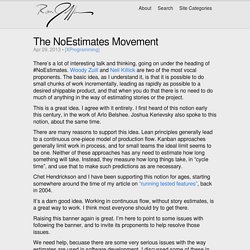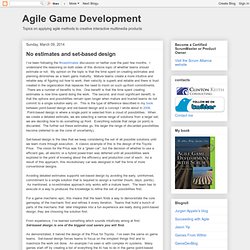

How to Stop the Planning Fallacy From Disrupting Your Projects - LiquidPlanner. This week I’m rushing to review a book chapter before sending it back to the editor.

I have known about this deadline for months, and I am not the kind of person to leave the work to the last minute. The truth is, doing the review is taking far longer than I accounted for. Estimate This! (or not) My friends and colleagues in the #NoEstimates circles have some good ideas, as I've commented elsewhere.

I'm left, though, with a couple of concerns. First, if someone with a need and money to spend wants to get started, what should they do? It doesn't seem like good advice to tell them to start spending money and see what comes out. After all, not every team they might encounter can even deliver product in the necessary incremental way. Furthermore, the buyer might not want to start at all if the costs are going to be huge.
Second, given that there are a lot of people with problems and a desire for some way of estimating the cost, people need some help with techniques for weaning them away from estimates where it's possible. The NoEstimates Movement. There’s a lot of interesting talk and thinking, going on under the heading of #NoEstimates.

Woody Zuill and Neil Killick are two of the most vocal proponents. The basic idea, as I understand it, is that it is possible to do small chunks of work incrementally, leading as rapidly as possible to a desired shippable product, and that when you do that there is no need to do much of anything in the way of estimating stories or the project.
This is a great idea. I agree with it entirely. I first heard of this notion early this century, in the work of Arlo Belshee. There are many reasons to support this idea. Chet Hendrickson and I have been supporting this notion for ages, starting somewhere around the time of my article on “running tested features”, back in 2004. PragPub April 2013. Two months ago in these pages, Ron Jeffries told us estimation is evil.

Now he’s back to tell us it’s a necessary evil—and that, done right, it isn’t even evil. Yes, there are many abuses that organizations perpetrate around the notion of estimation. Most developers have been injured by these abuses more than once in their career. The perils of estimation. Business people want estimates.

They want to know how much it’s going to cost them to get a solution, and they want to know how likely it is to come in on time and on budget. And of course quality is not negotiable. Agile teams I encounter are at best nervous about estimates and at worst simply evasive. “You don’t need estimates if you’re doing Agile,” they say. “It will be ready when it’s done. We’re missing the point of release planning My favourite exchange goes something like: “We’ve done an inception and broken down the entire project into stories and measured it, and it’s come in at 400 stories, estimated at 865 story points.” “865 what?”
“865 story points.” “So how big is a story point?” “We don’t know yet, we’ll let you know in a few weeks.” At a governance and funding level the business could care less about story points. So how do we approach that? 1. No estimates and set-based design. I’ve been following the #noestimates discussion on twitter over the past few months.

I understand the reasoning on both sides of this divisive topic of whether teams should estimate or not. My opinion on the topic is that the time spent on creating estimates and planning diminishes as a team gains maturity. Mature teams create a more intuitive and reliable way of figuring out how to work, their velocity is superb and reliable and there is trust created in the organization that replaces the need to insist on such up-front commitments. There are a number of benefits to this. One benefit is that the time spent creating estimates is now time spend doing the work. Set-based design is the idea that we keep considering the set of all possible solutions until we learn more through execution.
Avoiding detailed estimates supports set-based design by avoiding the early, uninformed, commitment to a single solution that is required to assign a number (hours, days, points). AgileQuotes.com. Magic numbers of project management. No matter where I go, or what industry I’m talking to, if I ask enough questions of people who have schedules for important things eventually I hear a magic number.A magic number is a mystical multiplier used to figure out schedules.

Sometimes it’s small, other times it’s large. But regardless of the size, very smart people managing very important things bet their projects on these numbers without having any logical reason for doing so. Typically the origins are mystical: we use this number because we’ve always used this number. That’s not a good basis for doing much of anything. Here’s the list of the common ones, plus some better ways to compute proper estimates. Common magic numbers in the wild: The NoEstimates Movement. Michael Wolfe's answer to Engineering Management: Why are software development task estimations regularly off by a factor of 2-3.